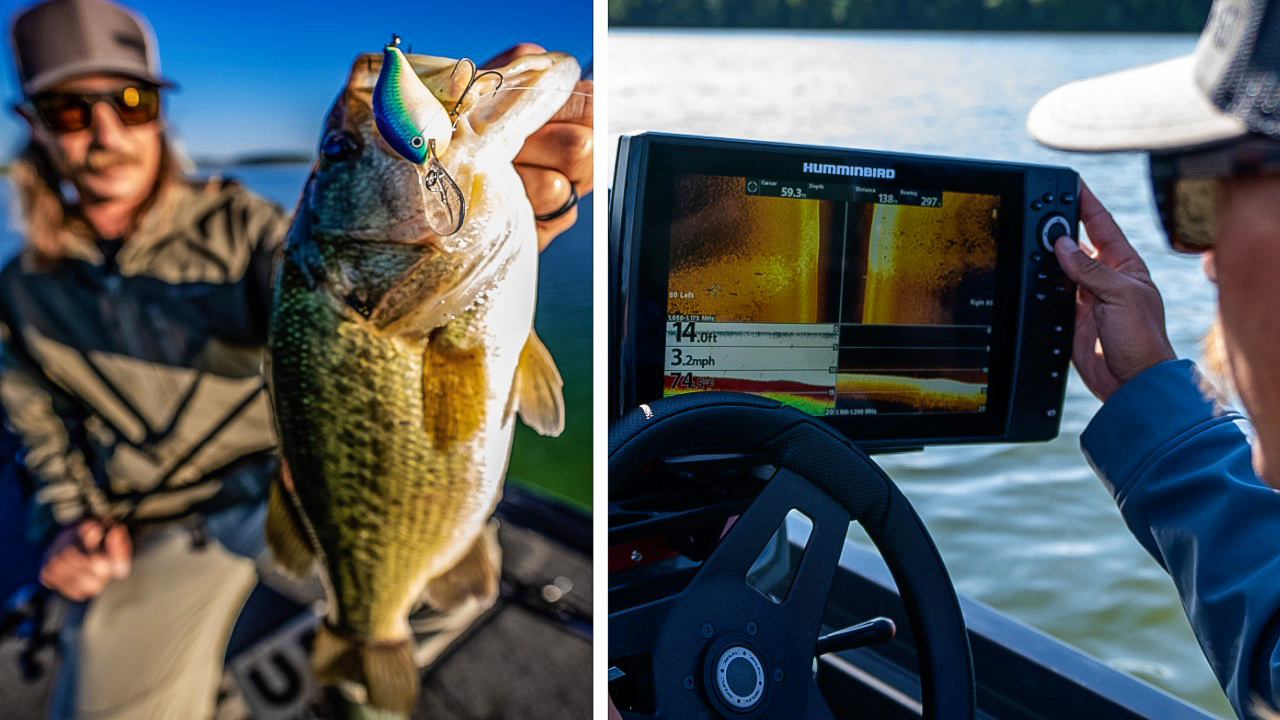Seth Feider takes us through his process of breaking down a new lake to find and catch bass using side imaging and waypoints to map out productive spots. He then showcases the power of a crankbait for locating bass, followed by a finesse bottom presentation to catch several additional fish. Feider takes a seemingly complex or challenging fishing situation and turns it into a simple step-by-step process that leads to success, and the beauty is that we can all do the same.
FISH FINDERS and BOAT EQUIPMENT
- FISH FINDERS – Humminbird HELIX 12 MEGA SI+ G4N
- 360 SONAR – Humminbird MEGA 360 Imaging
- TROLLING MOTOR – Minn Kota Ultrex Trolling Motor
- SHALLOW WATER ANCHORS – Minn Kota Raptors, 8′
- MOTOR – Mercury Pro XS 250hp
- BOAT – Ballistic Boats 204
FEATURED TACKLE
CRANKING SETUP
- CRANKBAIT – Rapala DT 8
- ROD – Daiwa Tatula Series Casting Rods, 7’0″ / Medium / Regular
- REEL – Daiwa Tatula Elite Casting Reel, Left / 6.3:1
- LINE – Sufix Advance Fluorocarbon, 12-pound
FINESSE SETUP
- TOKYO RIG – VMC Tokyo Rig Finesse Neko, size 1
- WEIGHT – VMC Tungsten Worm Weight, 3/16 oz / Black
- PLASTIC – Z-Man Big TRD, PB&J / 4″
- REEL – Daiwa Exist 2022 Spinning Reel, size 3000
- ROD – Daiwa Tatula Elite Series Spinning Rods, Seth Feider Hair Jig/Neko, 7’6″
- LINE (braided mainline): Sufix 131 Braided Line, 10-pound, Low Vis Green
- LINE (leader) – Sufix Advance Fluorocarbon, 8-pound
- Scan with side imaging. Side imaging sonar is essential for mapping out a mapped or unmapped lake. Even if there are detailed contours (there weren’t on this lake), side imaging adds vital context by showing what’s on the bottom (e.g., rock, wood, weeds) and bottom composition characteristics (hard, soft, and transitions). Bass don’t eat contour lines but do eat crawfish, and crawfish live in rocks. Feider scans and finds an offshore rock pile loaded with boulders, and we’re off to the races.
- Drop waypoints on key edges. Again, contours don’t show you edges, but side imaging does. Feider advises adding waypoints on the edges of the structure you wish to fish — this action is equivalent to drawing a contour line around the structure’s perimeter. In this case, Feider chooses to drop these waypoints on the crown of the rock pile (highest point) and at the ends to have a casting target when he gets on the bow.
- Stay off the spot. Waypoint sharing between console and bow electronics has been around for a while yet remains (and always will) an essential capability for putting your reconnaissance efforts to work on the bow where it counts. References your waypoints on the bow and keep your boat off of where you expect the fish to be. For Feider, this means positioning his boat off the edge of the rock, out in the basin mud, then making a long cast up onto the structure. Treat fishing like deer hunting. They’re often boat shy, so stack the odds in your favor by staying off them. Feider takes it a step further by using 360 Imaging to see his waypoints on top of a detailed structure readout — this is the ultimate way to see a terrain map.
- Use a moving bait first. Use a moving bait first. So you found a good-looking spot, but bass usually position on a sweet spot on a good spot! While many lures work, Feider loves a crankbait to work quickly across the bottom at specific depth ranges — they fish fast, and bass can’t resist, especially around rocks holding crawfish and bluegills. He fishes along, eliminating unproductive water. Stop your boat, make repeated casts to where you hooked your first fish, and expand your search by fanning your casts out, all without moving your boat. Spot-Lock makes this process easy. Check out this video on how Feider “milks” a school using a series of baits in order.
- Change to a finesse bait. A reaction bait like a crankbait is an excellent tool for triggering the most aggressive bass, but there are usually several more that aren’t willing to chase or are “tuned-up” from the crankbait. Go finesse. Feider chooses a bottom finesse presentation, opting for a super durable Z-Man ElaZtech stickbait rigged on a VMC Tokyo Rig Finesse Neko. He casts the bait back to the same spots the crankbait produced and catches several more, including his biggest of the day. He explains the benefits of the Tokyo Rig setup over a drop shot while still retaining drop shot-like benefits.
















